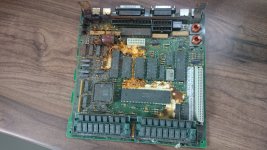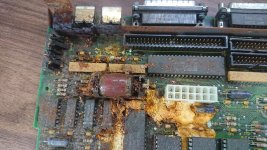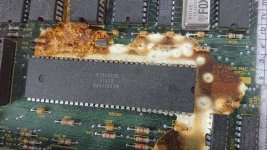Kai Robinson
Well-known member
It's basically a Xerox, for PCB's - but there's no easy way to scan it in 
Your project is just amazing, following it with intensity.I was involved in the reverse engineering of the Amiga 500+, Rob Taylor (@PeepoUK in twitter) was the man behind that idea - he since went on to do all the models of C64 board. We've got a discord server, and after watching Adrian Black's repairathon, i realised that no one had done this for a Mac...there's no reason to not do it either, so...i volunteered
Given X-Ray(?) technology capable of non-destructively testing ridiculousl complex layered CPU's and the like for tweaking production and Trojan Horse detection, I cannot imagine that a layered scan of the SE/30 or any other board could be all that problematic.Also, id love for this to be done with the SE/30. I have a pile of those boards dead and screwed from battery juice. Be forewarned, the SE/30 has traces that run in the middle layers as I saw, and I am not sure how your approach would be for that.
I mean, the difference between a sander and an x-ray machine is just the size of the particles, not the actual result, amiriteorbital sander
Nope, just a link to an IEE Spectrum article on Ptychographic X-ray laminography. [You have an x-ray machine handy? Yea.....
LCIII PDS has more than one (maybe all three?) Interrupts/Slot IDs in its pinout, but in every case they're tagged with: Not used in the LCxx. That suggests a ROM limitation to me.Just out of curiosity: can the PDS slot on the SE be broken out into multiple slots like the later LC PDS slots? On the LC, even though there's only 1 physical slot, it has address locations for up to 3 (I think) slots.
The 1988 revision jibes with development of the SE/30 which shipped January 19, 1989. SE/30's new chassis with provision for vertical PDS expansion was adopted for late SE production. Have you seen an early SE/30 with tabs on both sides? By 1988, SE upgrades were all but standard equipment, they were far larger than Apple's spec for board size and pushed the vertical limit for installation. Directions for products as early as the Radius16 specified the "pry the sides of the chassis apart method" of installation. So I wonder if they slotted the 1988 revision SE board on both sides to ease expansion, putting less compression and flexion stress on chassis and motherboard? With its vertical expansion slot, the SE/30 didn't have any pressing need for cutouts on both sides, but I'm curious if any did?Thats funny. ive seen them on both sides. Maybe different board revisions were different?
FWIW my SE board which came with the SE/30-style chassis has no cutout.The 1988 revision jibes with development of the SE/30 which shipped January 19, 1989. SE/30's new chassis with provision for vertical PDS expansion was adopted for late SE production. Have you seen an early SE/30 with tabs on both sides? By 1988, SE upgrades were all but standard equipment, they were far larger than Apple's spec for board size and pushed the vertical limit for installation. Directions for products as early as the Radius16 specified the "pry the sides of the chassis apart method" of installation. So I wonder if they slotted the 1988 revision SE board on both sides to ease expansion, putting less compression and flexion stress on chassis and motherboard? With its vertical expansion slot, the SE/30 didn't have any pressing need for cutouts on both sides, but I'm curious if any did?



